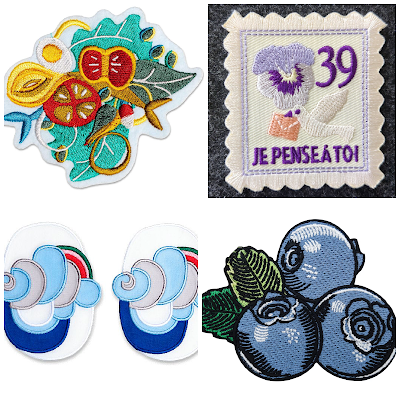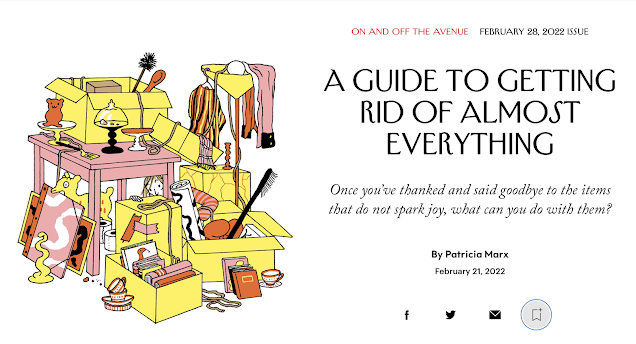Pins and patches: Fixing is the new black
The Sojo website wants to know me faster than a round of speed dating: Where do you live? What would you like to repair?
At present, the new alterations business serves only London, promising to rescue the time-starved and ill-fitted. Its model is disruptive: patrons never visit a shop. Sojo assesses and prices the request, picks up the garment, and delivers after alteration or repair.
To test its process, I tried booking salvation for a crocheted pencil skirt made of at least sixty black granny squares, which was two sizes too big after my weight dropped. No tailor in my city would touch it because of the matching required for the 4-inch squares. Could Sojo handle it?
Sojo got down to business: "How would you like your skirt to be altered?" (I chose "taken in on sides".) They then put me to work: "Match or pin your skirt to help us get the perfect fit." I was directed to a You Tube video:
"Matching" means finding an item that fits perfectly —you are supplying them with a model garment to replicate, and, the woman in the video says, "it is essential to get it right".
You lay your ill-fitting item on your perfect-fit item (which should be the same material and style), and pin it to show the difference. I'm not up to it; I want to stand on a dais with the tailor whirring around me; I want them to use their eyes and hands, because tailoring is both art and science. It is the tailor who sees that one hip is slightly higher than the other, or who suggests topstitching to tame a curled seam.
I felt as if I were making a restaurant reservation and then supplying the recipes.
If I lived in London and still owned the skirt, I might try Sojo, but am wary after a history of failures: the personable young woman who took in the sleeves of my tweed blazer so aggressively that I could not bend my elbows, the laconic Russian who fitted a MaxMara dress precisely, but the pockets never aligned again.
I found a good local shop, but the prices mean I need at least another five years of life to amortize taking in a pair of trousers. I will now refuse to acquire anything that requires an entire garment be filleted like a fish, then reassembled so deftly that any work is undetectable. Maria, a neighbour, is the opposite, fearless about having coats recut and dresses transformed to skirts.
Concurrently, some women are taking matters into their own hands. The sale of garment-repair materials and notions has skyrocketed, according to a recent article in The Guardian, "Trend to mend: cost of living crisis puts darning back into vogue". I thought that Notions, once my favourite part of the classic department store, had vanished like the Ladies Lounge. Can you too be lulled into bliss by a wondrous wall of ribbons and trims, voluptuous drawers of patterns, button boxes encrusted with their pert contents?
Visible mending has roared to the fore; I like how Eliane, a quilt and pattern designer who writes the blog Patchwork and Poodles, shortened her thrift-store jeans by applying sashiko stitching to the turn-up instead of the usual chop-and-hem:
 |
| Photo: Patchwork and Poodles |
For the first time in decades, rather than resort to the drycleaner's hit and miss efforts, I darned a three-corner tear in my jeans, instructed by a homey YouTube video. Let's say it's a learning project; I am not the Agnes Martin of stitching.
There are options for the darning-challenged; designer patches from Macon & Lesquoy will cover holes, snags and permanent stains. When a permanent stain marred one of my favourite bags, a M&L patch saved it—and they are such fun! Even when sold as an iron-on, I have a patch sewn in place. "L'oeil de David Bowie!" exclaimed the teenaged cobbler.
You can also find patches from charming to cheeky on Etsy, some for less—but M&L patches last.
"Nicoise Salad" patch, Macon & Lesquoy; price, €20
"Je Pense à Toi" French postcard patch, UPlusStudio (Etsy); price, about $CDN 7
Blueberries patch, $CDN 11, FinallyHome Design (Etsy).
"Clouds" elbow or knee pads, Macon & Lesquoy, flexible and solid, and way more fun than plain ovals. Price, €40
As the child of a Depression-era mother, I grew up with the turned collar, the prom dress transformed into a skirt, shirts recycled as potholders. It was a mark of womanly capability, and no one wore that badge as proudly as Mom. I'm happy that skills once viewed as quaint have gained renewed respect.
As Mother's Day approaches, I think of her, and wonder about your own stories. What clothing or accessories did your family revive? Did you continue that practice?






Comments
For your skirt, Duchesse, I wouldn't have touched it. I don't do granny squares and would have referred you. Then there is matching the yarn, which I see as the biggest challenge. However, what I would have done is perhaps added a line of silk satin down each side, a la tuxedo, and maybe a new waistline of the same satin. What do you think? My consultations are free!
Delighted, Bunny, to hear about your side gig, which takes not only the eye but the ability to work meticulously.
I donated the MaxMara knit skirt. Before that, I consulted expert alteration shops and they said, impossible. It had been knit in one piece like a tube made on a knitting machine, so it was seamless. I did not want any other fabric used than the knit, which was fairly heavy.
Taking a tailored coat apart as you did reminds me of a friend whose husband died. He had several gorgeous cashmere sports coats he had barely worn since he bought them in England. She had them recut as blazers for herself. Obviously she wanted the memory of Ted; that work cost nearly much as buying new ones! They were relined with more feminine fabric, too.
My sister was a whizz at everything - she could hand-sew, dress make, knit and crochet really well. So she ended up doing a lot of hemming and turning of cuffs once she was older.
I can hand-sew and darn well, but that's pretty much it. I have fond memories of teenaged Saturday afternoons, sitting with my cousin and listening to records while we carefully mended the runs in our school tights!
I remember reading a rather lovely article in the Sunday Times by Flora Gill. She had had some of her late father's (the writer and dandy A A Gill) bespoke suits re-tailored to fit her and had clearly found the process helpful in dealing with her grief.
Last Summer I got my husband's faithful Harris tweed jacket re-lined. 25 years of frequent wear had shredded parts of the lining, though the tweed remained in excellent condition of course - that stuff is made to last. He was delighted with the result and the somewhat expensive work involved was certainly worth it.
Harris Tweed will live forever, like Legos!
One can only imagine what price such work would command these days...
It is about traditional crafts learning.
Happy Mother’s Day
As for the cost of supplies, in thrifts, I often see knitting needles (but hardly ever yarn) and large pieces of fabrics. It may not be the perfect colour or pattern but if someone wants to learn to sew on a machine, it's an option. (Sometimes it's really good fabric!) A number of community centres offer sewng courses but so far I have seen none offering hand-sewing. And you are right, enrolment has surged.
I can’t help thinking about my granny, who had mad skills with a needle. She made beautiful quilts as well as embroidered pillowcases that she finished with a border of hand-crocheted lace. She taught me to sew on her treadle sewing machine (which I still have). Am happy that one of my daughters has really developed an interest in sewing and also taught herself to knit; she’s made some beautiful sweaters!
I was curious about my own city so looked for clothing repair classes. I found a three-hour workshop for beginners, "Learn How to Repair Your Clothes". However, price is $70, not bad for a private provider but it gave me an idea. I'm going to talk to the community agency on my street; they offer sewing classes at much lower cost,, but not oriented toward repair. Perhaps they would add one. There are also good online tutorials on hemming and mending tears.
Your grandmother's pillowcases sound exquisite and made me think how rare it is these days that persons take the time and care to make everyday objects beautiful, by their own hand.